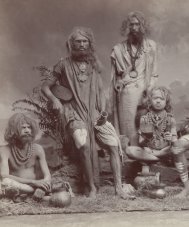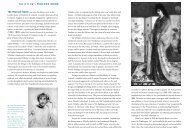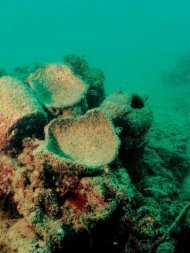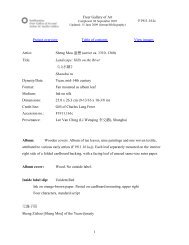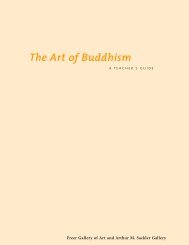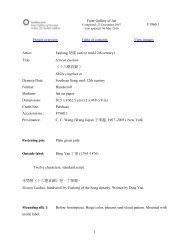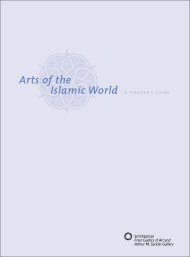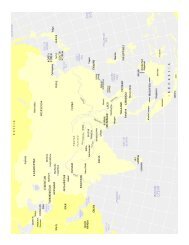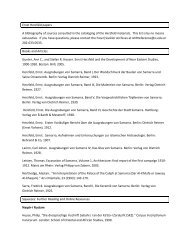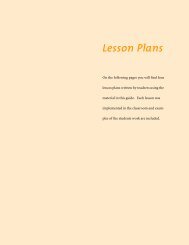Lesson Plans - Freer and Sackler Galleries - Smithsonian Institution
Lesson Plans - Freer and Sackler Galleries - Smithsonian Institution
Lesson Plans - Freer and Sackler Galleries - Smithsonian Institution
Create successful ePaper yourself
Turn your PDF publications into a flip-book with our unique Google optimized e-Paper software.
<strong>Lesson</strong> <strong>Plans</strong><br />
On the following pages you will find<br />
four lesson plans written by teachers<br />
using the objects in this guide for inspiration.<br />
Each lesson was implemented<br />
in the classroom, <strong>and</strong> examples<br />
of student work are included.
sub jects:<br />
art/language arts<br />
grade lev e l:<br />
elementary school<br />
time ne e ded:<br />
three to four fortyminute<br />
class periods<br />
74<br />
1<br />
T H E ART S OF JAPAN<br />
lesson plan<br />
How to Haiku: Poetry Reflecting<br />
the Feelings in Art<br />
B A SED ON “WAVES AT MATSUSHIMA” BY SOTATSU<br />
CONT R I BUT ED BY LISA O’NEILL AND TONI CONKLIN,<br />
B ANCR OFT ELEMENTARY SCHOOL, WA SHI NGTON, D.C.<br />
Goal<br />
To write a haiku inspired by the brilliant painting “Waves of Matsushima”<br />
by Sotatsu.<br />
Objectives<br />
• Students will identify the elements of haiku.<br />
• Students will identify the subjects in examples of haiku they read.<br />
• Students will identify <strong>and</strong> describe the objects in the l<strong>and</strong>scape painting<br />
“Waves at Matsushima.”<br />
• Students will explain the feelings that the elements in the painting evoke.<br />
• Students will write a haiku based on the painting.
1<br />
Vocabulary<br />
Adjectives descriptive words that create clear pictures <strong>and</strong> feelings about a subject<br />
Contemplative a state of deep thought<br />
Contrast two or more things that differ noticeably from one another in one or<br />
more ways<br />
Elements meaningful parts of a whole<br />
Feelings emotions that include happiness, sadness, loneliness, joy, fear, wonder,<br />
amazement, surprise, courage, etc.<br />
Haiku One of the shortest poetry forms, originating in Japan, which focuses on<br />
nature, color, seasons, <strong>and</strong> contrasts. Haiku expresses a feeling <strong>and</strong> often<br />
contains a surprise.<br />
L<strong>and</strong>scape art a painting or drawing that depicts a scene in nature<br />
Metaphor a phrase that compares two things to show similarities (for example, “you<br />
are a shining star”)<br />
Syllable The smallest segment of a word or sentence that can be clapped out. The<br />
unit of pronunciation that is organized around a vowel; it may or may not<br />
have consonants before or after the vowel.<br />
Verbs words that describe actions<br />
LESSON PLAN ONE 75
76<br />
1<br />
Day One<br />
Motivation <strong>and</strong> Discussion<br />
Discuss with students what they know about poetry. Then, introduce several haiku poems <strong>and</strong>,<br />
through creative discovery <strong>and</strong> “think aloud” techniques, solicit as many of the elements of the<br />
form as possible from children (nature, three lines, feelings, metaphor, contrast).<br />
Students will then read the following paragraph about haiku.<br />
Haiku is perhaps the shortest poetry form in the world. This tiny poem can say important<br />
things about how we feel about the world around us. Haiku was invented hundreds of<br />
years ago in Japan. It was used to express feelings about nature, animals, <strong>and</strong> the seasons<br />
at a particular time <strong>and</strong> place <strong>and</strong> to share those feelings with others. It is a contemplative<br />
or thoughtful form of poetry that focuses on nature, color, seasons, contrasts, <strong>and</strong> surprises.<br />
The first line contains five syllables; the second line contains seven syllables; <strong>and</strong><br />
the third line contains five syllables. So, to write a haiku means to capture how you feel<br />
at a certain moment in time, even if you are writing it down sometime later.<br />
After reading the paragraph, ask students to comment on the elements they had already<br />
mentioned in the poetry <strong>and</strong> to identify new ones. This will provide an opportunity for the<br />
teacher to do a h<strong>and</strong>-clapping activity that breaks words into their syllables. Students should<br />
then look at each of the haiku they read, checking to see if each line has the appropriate<br />
number of syllables <strong>and</strong> discussing the words (verbs, adjectives, etc.) that convey feelings to<br />
the reader. Students can work in small groups, concentrating on one poem <strong>and</strong> then sharing<br />
their conclusions with the whole group.<br />
Activity<br />
m aterials<br />
• Several large pictures of “Waves at Matsushima,” downloaded from the <strong>Freer</strong> <strong>and</strong> <strong>Sackler</strong><br />
website (www.asia.si.edu)<br />
• Pencils<br />
• Chart paper<br />
• Multiple copies of the thesaurus <strong>and</strong> dictionary<br />
• Watercolor sets with brushes<br />
• Gold pens<br />
• Gold glitter<br />
• Large white drawing paper<br />
T H E ART S OF JAPAN
Day Two<br />
1<br />
1. Review the elements of haiku using the self-assessment rubric. (See “assessment <strong>and</strong><br />
evaluation.”)<br />
2.Tell students that they are going to write a haiku based on a beautiful painting by Sotatsu,<br />
a Japanese artist who created two folding screens of the l<strong>and</strong>scape at Matsushima (Pine<br />
Isl<strong>and</strong>s). (See “Waves at Matsushima,” page 64.) Show students how the panels fold up,<br />
using the copies.<br />
3. Through “creative visualization,” students close their eyes <strong>and</strong> imagine themselves alone<br />
somewhere “in” the picture. Tell them to think about what they see, hear, touch, <strong>and</strong> feel.<br />
4. Next, in whole group or small groups, have students make lists of colors, adjectives, verbs,<br />
nouns, <strong>and</strong> feelings that came to mind as they imagined themselves “in” the screen painting,<br />
a copy of which they have in front of them.<br />
5. Discuss the difference between regular words <strong>and</strong> exciting, thought-provoking ones;<br />
model the use of a thesaurus <strong>and</strong>/or dictionary to find such words.<br />
6. Look throughout the picture <strong>and</strong> see if children can identify elements that look familiar<br />
to them.<br />
7. Make a list of all their ideas on a chart at the front of the room, <strong>and</strong> encourage students to<br />
think about a feeling they could express in a haiku, using some of the words from this chart.<br />
8. Students write their haiku <strong>and</strong> check it against the rubric. Peer <strong>and</strong> teacher conferencing<br />
works well to clap syllables <strong>and</strong> brainstorm on word use.<br />
Day Three<br />
1. Students will draw a picture on a large piece of white paper, depicting that part of the<br />
painting their poem most speaks to.<br />
2. After drawing the outline of the picture, students will proceed to paint it with watercolors.<br />
3. After the paint dries, students will choose where to add the gold “threads” with their gold<br />
pens <strong>and</strong> glitter.<br />
4. Finally, students choose either to write their haiku on their painting or copy it neatly on<br />
writing paper.<br />
LESSON PLAN ONE 77
78<br />
1<br />
Assessment <strong>and</strong> Evaluation<br />
The following rubric can be used for students to self-assess <strong>and</strong> also for the teacher to confirm<br />
that each haiku meets the criteria.<br />
Haiku Rubric<br />
Grade yourself! Read each question. If you are able to answer yes to the question, give yourself<br />
one point. An excellent haiku will have a total of six points.<br />
Does my haiku have three lines? _________________<br />
Does my first line have five syllables? _________________<br />
Does my second line have seven syllables? _________________<br />
Does my third line have five syllables? _________________<br />
Does my haiku express how I feel at a specific moment in time? _________________<br />
Does my haiku focus on one of the following? _________________<br />
Circle one or two elements that your haiku contains:<br />
NATURE COLOR SEASON SURPRISE<br />
T H E ART S OF JAPAN<br />
total poin t s _________________<br />
teache r’s signat u re _________________
1<br />
Student Work<br />
Twirling <strong>and</strong> swirling<br />
Waves sliding like spaghetti<br />
Slipping off the rocks.<br />
by Jocelyn<br />
Wild water splashing<br />
Washing colorful green rocks<br />
I’m wet looking on.<br />
by Shantell<br />
A giant hammock<br />
Resting place for splashing waves.<br />
Wish I was there too.<br />
by Enris<br />
st<strong>and</strong>ing in the waves<br />
tall rocks block the strong splashes<br />
solid rounded shape.<br />
by Angela<br />
topsy turvey waves<br />
water splashing on the rocks<br />
topsy turvey waves<br />
by Jonas<br />
The dragon’s a beast<br />
Waves destroying the mountain<br />
It squashes the l<strong>and</strong>.<br />
by Abiy<br />
LESSON PLAN ONE 79
sub jects:<br />
art<br />
2<br />
grade lev e l:<br />
intermediate elementary<br />
school; adaptable to<br />
middle <strong>and</strong> high school<br />
time ne e ded:<br />
three to four one hour<br />
class sessions<br />
80<br />
T H E ART S OF JAPAN<br />
lesson plan<br />
Kenzan <strong>and</strong> Korin: Collaboration <strong>and</strong><br />
Integration in Ceramic Design<br />
CONT R I BUT ED BY PAT R ICK T IMOT H Y CAUGHY, C ENT ENN IAL LANE ELEMENTARY<br />
SCHOOL AND HOWARD COUN TY PUB LIC SCHOOLS<br />
Goal<br />
To investigate for inspiration a ceramic exemplar produced in collaboration<br />
by artist brothers, Ogata Kenzan <strong>and</strong> Ogata Korin, <strong>and</strong> to gain an<br />
underst<strong>and</strong>ing of the merging of two media (in this case, ceramics <strong>and</strong><br />
painting) to produce a unique object.<br />
Objectives<br />
• Students will explore the interrelated arts of pottery, painting, <strong>and</strong> literature<br />
in the cultural life of Edo-period Japan.<br />
• Students will view <strong>and</strong> respond to work by both Kenzan <strong>and</strong> Korin <strong>and</strong><br />
learn how to identify characteristics of their styles.<br />
• Students will produce an original h<strong>and</strong>-built, decorated, <strong>and</strong> glazed<br />
ceramic plate using elements of design evident in the collaborative work<br />
of Kenzan <strong>and</strong> Korin.<br />
Vocabulary<br />
Ceramic ware clay products, often used in the preparation, storage, <strong>and</strong> serving of foods<br />
Characteristic the properties unique to a style or expression<br />
Collaboration individuals or groups working together to accomplish a purpose<br />
Design a visual plan for an artwork<br />
Edo period Japan of the period between 1615–1868 that was characterized by a rise of<br />
the merchant class, growth of urban areas, <strong>and</strong> blossoming of the arts.<br />
Glaze the outer surface, often glasslike, of a ceramic piece<br />
Style a unique manner of expression
2<br />
Motivation <strong>and</strong> Discussion<br />
Show students the image of the Kenzan/Korin tray “Square dish with design of ‘Eight<br />
Bridges.’” Ask students to critique the tray based on the process below developed by<br />
Edmund Feldman, author <strong>and</strong> arts educator:<br />
1. describe<br />
Students should look at the object carefully <strong>and</strong> describe it.<br />
2. analy ze<br />
Students should take their initial descriptions <strong>and</strong>, based on their observations, analyze how<br />
the work is composed. Ask students to look for patterns <strong>and</strong> connections.<br />
3. i n terpret<br />
Using their analysis, students should explore why they think the artist made the choices<br />
he/she did in this particular work.<br />
(In this exercise, there will be no “Evaluation,” as is customary in a Feldman critique.)<br />
Some prompting clues for the students may also include the questions:<br />
• Where am I?<br />
• When am I there?<br />
• What is around me?<br />
Explain the tradition in Japanese art of drawing inspiration from nature, literature, fashion—<br />
either separately or, sometimes, in combination. In the instance of the Kenzan/Korin tray, a<br />
passage from a work of literature familiar to many literate people provided the inspiration for<br />
the design. Give students information on the literary source for the visual image on the tray.<br />
(See “Square dish with design of ‘Eight Bridges,’” page 25.)<br />
Describe the way Kenzan <strong>and</strong> Korin collaborated to produce ceramic work that represented<br />
an innovation for the Edo period. Ask students to consider the challenges <strong>and</strong> advantages of<br />
such a collaboration. Students should begin to think about ways that they would combine<br />
painting <strong>and</strong> ceramics in the manner of Kenzan <strong>and</strong> Korin (albeit as one artist).<br />
LESSON PLAN TWO 81
82<br />
Activity<br />
2<br />
m aterials<br />
• Low fire white stoneware<br />
• Rolling pins<br />
• A variety of grocery store Styrofoam trays<br />
• Paper towels<br />
• Black underglaze slips or stains<br />
• Bamboo brushes<br />
• Ink<br />
• White paper<br />
• Clay tools <strong>and</strong> cleaning supplies<br />
• Large plastic Ziploc bags<br />
• Large paper clips<br />
1.Direct students to roll an orange-size ball of clay <strong>and</strong> to form it into a slab. This may be<br />
rolled out, flung, <strong>and</strong> stretched to a thickness of ¼ to ½ inch.<br />
2.Have students press their slabs into foam plates or trays. A barrier between the clay <strong>and</strong><br />
the tray, such as a paper towel, may be useful.<br />
3.Clay around the plate edge should be trimmed with an extended paper clip. If necessary,<br />
students may store this work in a sealed plastic bag with a label until the next class period.<br />
4.The teacher will offer students a guided practice with bamboo brushes, ink, <strong>and</strong> paper in<br />
preparation for their ceramic decoration. Images of seasonal flowers should be presented<br />
for inspiration, <strong>and</strong> students should be asked to keep in mind the stylistic model of the<br />
Korin decoration.<br />
5.Using underglaze stains, students will decorate their plates. Review aspects of the<br />
Kenzan/Korin style.<br />
6. After bisque firing, a coat of clear matte glaze will seal the work for use at home <strong>and</strong> give<br />
it protective permanence.<br />
T H E ART S OF JAPAN
2<br />
Assessment <strong>and</strong> Evaluation<br />
1. class discussion summary Use a visual web designating three key areas of reflection<br />
as a review of the lesson.<br />
• Culture<br />
• Clay<br />
• Collaboration<br />
Invite students to comment on what they learned about these aspects of the lesson.<br />
2. artist statemen t s From the visual web above, students may write captions for their<br />
artwork.<br />
3. imaginativ e letter Reflecting again on the collective, student response web, students<br />
will write letters detailing their clay experience. The letter may be addressed to one of the<br />
Kenzan ceramics craftsmen, inquiring about their training <strong>and</strong> career. Or it may be<br />
addressed to a classmate or relative, describing the sequence of production in completing<br />
the goal.<br />
Possible Extension<br />
Students can compose a haiku (a three-line, seventeen-syllable poem) about their ceramic<br />
piece to accompany the display of their painted plate <strong>and</strong> to emulate the Edo-period practice<br />
of visual <strong>and</strong> literary interplay.<br />
LESSON PLAN TWO 83
84<br />
2<br />
Student Artwork Samples<br />
T H E ART S OF JAPAN
sub jects:<br />
art/language arts/<br />
social studies<br />
grade lev e l:<br />
middle school to<br />
early high school<br />
3<br />
time ne e ded:<br />
Two ninety-minute class<br />
periods or three to four<br />
forty-minute class periods.<br />
It would be best<br />
to start this when the<br />
season is at its height,<br />
for example in the fall,<br />
when leaves are turning,<br />
or in the spring, when<br />
flowers are blooming.<br />
lesson plan<br />
Capturing a Moment: Art <strong>and</strong> Haiku<br />
CONT R I BUT ED BY LAU R A PHI N IZY, P Y LE MIDDLE SCHOOL, B ETH ESDA, M ARY L AND<br />
Goal<br />
To instill an appreciation for the way natural imagery <strong>and</strong> sensory information<br />
are used in the composition of a haiku poem.<br />
Objectives<br />
• Students will observe nature to collect sensory data in order to compose<br />
a haiku.<br />
• Students will learn to identify the seasons represented in Japanese art<br />
objects.<br />
• Students will compose their own haiku based on moments captured in<br />
Japanese art objects.<br />
Motivation <strong>and</strong> Discussion<br />
Day One<br />
1.Introduce the concept of haiku, a poem of seventeen syllables that captures<br />
one moment in nature. The poem consists of three lines <strong>and</strong> the syllabic<br />
structure is 5–7–5.<br />
2.Show students an excerpt of a video on Japan to give them a sense of the<br />
Japanese l<strong>and</strong>scape <strong>and</strong> aesthetic. Suggestions:<br />
• “Journey to a Lost Japan,” Travels, video, 50 minutes, 1991<br />
Thirteen/WNET. This is an episode of the PBS Travels series that follows<br />
the ancient pilgrimage route between three sacred mountains in<br />
Yamagata Prefecture, Japan.<br />
• “Beauty of Haiku Poetry,” Teachers Video Co. 18 mins.<br />
3.Read as a class some of the haiku by poets of all different backgrounds<br />
4.Have the students identify <strong>and</strong> write all the senses that these poems<br />
appeal to, for example, how snow feels cold to the touch.<br />
5.Have the students try to give the poems titles.<br />
LESSON PLAN T H R EE 85
86<br />
3<br />
Homework Day One Go out <strong>and</strong> take a walk for at least twenty minutes. Try to notice<br />
nature as you walk. Think of what you hear, see, smell, taste, <strong>and</strong> touch. When you get<br />
home, jot down the most vivid sounds, images, smells, or textures you encountered.<br />
Day 2<br />
1.Have students share with partners their homework: the most vivid sounds, images, smells,<br />
or textures they encountered the day before.<br />
2.Explain to them that they will be analyzing Japanese art. Like poets, the artists capture a<br />
moment in time by appealing to viewers’ senses <strong>and</strong> emotions. Explain that they will be<br />
observing <strong>and</strong> identifying first, then analyzing <strong>and</strong> writing.<br />
Activity<br />
m aterials<br />
• Color images of objects listed below<br />
• Photo of irises in bloom.<br />
• Haiku worksheet (see page 90)<br />
3.Present the following images one at a time to the students. With each object, have the students<br />
observe quietly for a minute or so before asking the following questions to spark<br />
analysis <strong>and</strong> discussion. Have students record their observations on the haiku worksheet<br />
(see page 90).<br />
• “Square dish with design of ‘Eight Bridges’” (see page 25)<br />
• “Boy <strong>and</strong> Mount Fuji” (see page 22)<br />
• “Square dish with design after poems of birds <strong>and</strong> flowers” (see page 49)<br />
• “Nabeshima ware dish with design of reeds <strong>and</strong> mist” (see page 46)<br />
(An alternative that can be used in place of the Nabeshima ware dish is the “Inkstone box,”<br />
page 62; adjust the observation questions as necessary.)<br />
T H E ART S OF JAPAN
3<br />
gui ding questions:<br />
object 1: “ square dish with design of ‘eight bridges’” (see page 25)<br />
• What kind of object is it? (tray)<br />
• What material do you think it’s made of? (ceramic or clay with glaze to look shiny)<br />
• How big do you think it is? (about 1 inch deep <strong>and</strong> 8.5 inches square)<br />
• What objects do you see? (It may help to have them start in one corner <strong>and</strong> move around.<br />
Grasses or reeds. Flowers. Large <strong>and</strong> small sticks. Writing in corner. Flowers around edges.)<br />
• What could the big sticks be used for? Hint: Look at their size compared with the flowers.<br />
Have you ever been walking outside <strong>and</strong> wanted to walk on sticks? Why? (Sticks are in fact a<br />
bridge.)<br />
• In what season would these flowers be in full bloom? (summer)<br />
• Tell students a version of the story behind the imagery (see object description, page 25)<br />
• Have students record on worksheet the senses that the artist appeals to in this object (for<br />
example: wet, slimy log; squishy ground; perfume of flowers; bright purple <strong>and</strong> green)<br />
• What emotions do you feel as you look at this? Write your answer down.<br />
object 2: “boy <strong>and</strong> moun t fu ji” (see page 22)<br />
• What kind of object is it? (painting)<br />
• How big do you think this is? (about 50 inches by 27 inches—show with your h<strong>and</strong>s)<br />
• What objects do you see? (mountain, snow, tree, boy, flute, bucket, water, ground, crater<br />
at top of mountain, writing <strong>and</strong> seal in corner, cloud) They may also be able to identify<br />
Mount Fuji, but if not, help them to underst<strong>and</strong> that it is a volcano. Explain a bit about<br />
Mount Fuji—that it is a symbol, a place where even today people make pilgrimages. One<br />
of the most beautiful sights in Japan is supposed to be sunrise from the summit, so many<br />
people hike all through the middle of the night to arrive there for sunrise.<br />
• Look at the water <strong>and</strong> the tree carefully. What season do you think this could be? (probably<br />
spring—no flowers anymore, but lots of water, maybe from snowmelt. If they think it is<br />
winter, you will need to explain the elevation effect, where the higher up you go, the colder<br />
the temperature is.)<br />
• What’s happening in the picture? (boy is playing flute while looking at nature)<br />
• What might have happened before or will happen after this? (boy should be gathering or<br />
carrying something in his bucket)<br />
LESSON PLAN T H R EE 87
88<br />
3<br />
• How is the story of this scroll similar to the story implied in the first tray? (stopping <strong>and</strong><br />
looking at nature, nature as an inspiration)<br />
• Have students record on worksheet the senses that the artist appeals to in this object (for<br />
example: roaring of water; melody of flute; texture of bark; vision of huge mountain; stickiness<br />
of air with rain cloud)<br />
• What emotions do you feel as you look at this? Write your answer down.<br />
object 3: “ square dish with design after poems of birds <strong>and</strong> flowers” (see<br />
page 49)<br />
• What kind of object is this? (tray)<br />
• How big do you think it is? (about 1 inch deep <strong>and</strong> 6.5 inches square)<br />
• What objects do you see on the tray? (tree, snow, bird, ground, grasses, pond with snow<br />
<strong>and</strong> ice, blue-<strong>and</strong>-white designs on rim)<br />
• What season do you think this is? (winter)<br />
• What do you think the bumps on the tree could be? (They may guess clumps of snow,<br />
but guide them to the idea of blossoms. These are plum blossoms.)<br />
• How is the story in this scroll similar to the other two objects? (The bird is paused in the<br />
middle of this winter scene.)<br />
• Have students record on worksheet the senses that the artist appeals to in this object (for<br />
example: cold, wet snow; crispy air; quiet of snow-muffled ground; quack of duck; variations<br />
of white <strong>and</strong> gray)<br />
• What emotions do you feel as you look at this? Write your answer down.<br />
object 4: “nabeshima ware dish with design of ree ds <strong>and</strong> mist ” (see page 46)<br />
• What is this? (a ceramic plate)<br />
• What do you see on it? (some kind of plant, two colors; some unpainted areas, some<br />
painted blue areas)<br />
• Why do you think there are two colors? (maybe changing colors with the season or dying)<br />
• What could the dark blue painted areas be? (sky, water, fog)<br />
• Why do you think the artist chose not to paint the whole plate? What could the<br />
unpainted parts be? (water, fog) Do you think it would have been better to paint the whole<br />
plate or leave us to fill in the gaps with our imagination?<br />
T H E ART S OF JAPAN
3<br />
• What season do you think this is? (fall)<br />
• Have students record on student worksheet the senses that the artist appeals to in this<br />
object (for example: spiky, wet, rotting blades of grass; damp fog or mist; squishy ground;<br />
maybe frogs or water bugs in the water)<br />
• What emotions do you feel as you look at this? Write your answer down.<br />
4. Have students choose one object. They should try to write as many 5–7–5 haiku as they<br />
can on that one subject, trying to appeal to multiple senses. Allow fifteen to twenty minutes<br />
for this activity. Slow down, perhaps using quiet music to calm the students.<br />
5. Have students pair up to peer edit. Have them circle sensory words <strong>and</strong> guess what emotion<br />
the author is trying to evoke.<br />
Homework Day Two Choose one of your poems to polish. Check for 5–7–5 structure,<br />
vivid sensory imagery, <strong>and</strong> emotion.<br />
Assessment <strong>and</strong> Evaluation<br />
Have students share their poems with the class <strong>and</strong> describe the process of writing the haiku.<br />
DID STU DENTS:<br />
• complete the homework assignments?<br />
• participate in class discussions?<br />
• follow the format of the haiku (three lines of 5–7–5 syllables)?<br />
• use descriptive words <strong>and</strong> sensory images in their haiku?<br />
• clearly attempt to capture a moment in time?<br />
Possible Extension<br />
Invite student volunteers to share poems aloud. Post the poems on a bulletin board with<br />
images of art. Have students repeat the haiku-writing exercise on the next day, focusing on<br />
new objects.<br />
LESSON PLAN T H R EE 89
90<br />
3<br />
name _________________________________________________________________________<br />
Student Worksheet—Haiku in Japanese Art<br />
For each object, list the senses that the artist evokes:<br />
object 1 ____________________<br />
Season ____________________<br />
Sight ____________________<br />
Smell ____________________<br />
Taste ____________________<br />
Sound ____________________<br />
Touch ____________________<br />
Emotion ____________________<br />
object 2 ____________________<br />
Season ____________________<br />
Sight ____________________<br />
Smell ____________________<br />
Taste ____________________<br />
Sound ____________________<br />
Touch ____________________<br />
Emotion ____________________<br />
T H E ART S OF JAPAN<br />
object 3 ____________________<br />
Season ____________________<br />
Sight ____________________<br />
Smell ____________________<br />
Taste ____________________<br />
Sound ____________________<br />
Touch ____________________<br />
Emotion ____________________<br />
object 4 ____________________<br />
Season ____________________<br />
Sight ____________________<br />
Smell ____________________<br />
Taste ____________________<br />
Sound ____________________<br />
Touch ____________________<br />
Emotion ____________________
3<br />
Student Work<br />
Inspired by “Square dish with design after<br />
poems of birds <strong>and</strong> flowers”<br />
Just There<br />
The bird sits, stairs, waits<br />
With winter dripping from the trees<br />
The spring slowly comes.<br />
by Alyssa<br />
The Smells of Winter<br />
Smelling hurts too much,<br />
In the middle of winter,<br />
With nothing but ice.<br />
by Laura<br />
Inspired by “Inkstone box”<br />
A little light means<br />
So much to a tree that has<br />
Been in dark so long.<br />
by Dimitry<br />
Inspired by “Boy <strong>and</strong> Mount Fuji”<br />
Wind pierces my skin,<br />
The distance below me grows,<br />
Now I feel alone.<br />
By Ellie<br />
Swish, the leaves rustle<br />
the wind whips the silent smoke<br />
water crashes down.<br />
By Emily<br />
Stream rushing below<br />
Looming mountain sheds its smoke<br />
Music moves with wind.<br />
By Melissa<br />
Inspired by “Nabeshima ware dish with<br />
design of reeds <strong>and</strong> mist”<br />
I’m the orange fox<br />
hiding in the thick luscious<br />
underbrush waiting.<br />
By Matthew<br />
LESSON PLAN T H R EE 91
sub jects:<br />
art/social studies<br />
grade lev e l:<br />
high school; adaptable<br />
to elementary <strong>and</strong><br />
middle school<br />
time ne e ded:<br />
three to four fortyminute<br />
class periods<br />
92<br />
4<br />
T H E ART S OF JAPAN<br />
lesson plan<br />
Here <strong>and</strong> There: Exploring Place in Art through<br />
“Boy <strong>and</strong> Mount Fuji”<br />
CONT R I BUT ED BY CORI N N E MU LLEN AND KEVIN SLIVKA, FREDERICK DOUGLA SS HIGH SCHOOL<br />
U PPER MARLBORO, M ARY L AND<br />
Goal<br />
To underst<strong>and</strong> the significance of Japan’s Mount Fuji, relate it to other<br />
similar places in the United States, <strong>and</strong> convey the importance of a cultural<br />
l<strong>and</strong>mark through visual art.<br />
Objectives<br />
• Students will list l<strong>and</strong>marks—places of cultural significance—in Japan<br />
<strong>and</strong> the United States.<br />
• Students will explore the painting “Boy <strong>and</strong> Mount Fuji” (see page 22)<br />
by describing <strong>and</strong> analyzing its content <strong>and</strong> approach.<br />
• Students will choose a cultural l<strong>and</strong>mark in Japan or the United States<br />
<strong>and</strong> illustrate that place, using “Boy <strong>and</strong> Mount Fuji” as inspiration, in a<br />
pencil or oil pastel drawing.<br />
Motivation <strong>and</strong> Discussion<br />
1. Ask students to write a short paragraph identifying <strong>and</strong> describing one<br />
place in Washington, D.C., that represents the United States. Have them<br />
include how they felt when they visited this place or saw images of it.<br />
Students should then share their paragraphs with a partner. Ask for volunteers<br />
to share their paragraphs with the entire class.<br />
2. Begin a discussion of cultural l<strong>and</strong>marks in the United States <strong>and</strong> Japan<br />
using the following questions:<br />
• What is, in your opinion, a place that represents the United States to the<br />
world? Why?<br />
• What is a place that might represent Washington, D.C., to the world?<br />
Can you think of one place of cultural significance to the Japanese people<br />
in Washington, D.C.?
4<br />
Students may already know about cherry blossoms, but if not, share with them that cherry<br />
blossom trees were given in 1912 by the people of Tokyo to the people of Washington, D.C.<br />
These particular cherry blossom trees are seen as a symbol of friendship between the United<br />
States <strong>and</strong> Japan. They are near the Tidal Basin in Washington, D.C. Every year there is a<br />
Cherry Blossom Festival in late March through early April, because around that time the<br />
trees bloom. Cherry blossoms are treasured in Japan because of their beauty <strong>and</strong> because<br />
the flowers are in bloom for only a short time each year.<br />
• What do you think is one place that is very sacred in Japan or special to the Japanese people?<br />
Why? Where did you learn about this place?<br />
3. Show students the image “Boy <strong>and</strong> Mount Fuji.” Ask them to take their time looking carefully<br />
at the image.<br />
4. Share with the class that the mountain (volcano) in the painting is Mount Fuji. Ask anyone<br />
to share what he or she knows about Mount Fuji.<br />
5. Initiate a discussion with the following questions:<br />
• Can you describe this image in detail? What are the different elements of the painting?<br />
• Why do you think the boy is dwarfed by Mount Fuji?<br />
• Write down three thoughts you might have if you were the boy gazing at Mount Fuji.<br />
• Have you ever traveled to a famous place in the United States? How did you feel when you<br />
were looking at the place from a distance?<br />
• What are some art materials you could use to express the feeling of the boy viewing<br />
Mount Fuji? Why would you choose those materials?<br />
LESSON PLAN FOUR 93
94<br />
Activity<br />
4<br />
m aterials<br />
• Paper<br />
• Pencils<br />
• Oil pastels<br />
• Digital camera<br />
1. Ask students to choose a place of cultural significance in the United States or Japan to<br />
depict in a drawing.<br />
2. Distribute paper, pencils, <strong>and</strong> oil pastels to students.<br />
Have students sketch the picture, using oil pastels to fill in the picture if they wish. Some<br />
students may choose to work solely in the pencil medium.<br />
3. While students are working on their drawings, ask students to come to you one at a time<br />
so that you can take a photograph of their back.<br />
4. When students have completed their drawings, have them cut their images out of the<br />
photographs <strong>and</strong> paste them onto the drawing so that they appear to be gazing at the place<br />
or structure they chose to depict.<br />
Assessment <strong>and</strong> Evaluation<br />
1. Did the student participate actively in the discussions?<br />
2. Did the student complete the project?<br />
Have students write an artist–statement label for their drawings, to be mounted with display<br />
of their work. This statement should include a passage on their underst<strong>and</strong>ing of the<br />
approach taken in “Boy <strong>and</strong> Mount Fuji,” an explanation of the choices they made in deciding<br />
which place to depict, <strong>and</strong> description of how they attempted to convey the importance<br />
of the place in their drawing.<br />
Possible Extension<br />
For schools in the Washington, D.C., area, a field trip to the Tidal Basin would be useful in<br />
early April. Have students sketch the Japanese cherry blossom trees with the Washington<br />
Monument or Jefferson Memorial in the background. Later, the pictures can be filled in<br />
with oil pastels. Students can also write haikus (three-line poems with syllabic structure of<br />
5–7–5) to capture a momentary aspect of the scene.<br />
T H E ART S OF JAPAN
4<br />
Student Work<br />
LESSON PLAN FOUR 95
96<br />
Resources<br />
Traditional Musical <strong>and</strong> Performing Arts of Japan:<br />
An Introduction <strong>and</strong> Resource Guide<br />
BY JOANNA PECORE<br />
Ove rview<br />
Japan has an extensive <strong>and</strong> diverse music <strong>and</strong> performing arts heritage that has developed<br />
in t<strong>and</strong>em with the country’s art <strong>and</strong> culture. These traditions have continuously thrived<br />
h<strong>and</strong>-in-h<strong>and</strong> with the visual arts, literature, religion, social life, <strong>and</strong> rituals. Therefore,<br />
many of the ideas <strong>and</strong> aesthetic principles that distinguish Japanese visual arts also resonate<br />
across the world of Japanese sound <strong>and</strong> performance. The most striking themes shared by<br />
these art forms are reflections on the transformations that constitute the physical world.<br />
As a complement to this teacher’s guide, this introduction is general <strong>and</strong> limited in several<br />
respects. First, it emphasizes Japan’s “traditional” music <strong>and</strong> performing arts, because the<br />
objects featured in this guide predate Japan’s era of “modernization,” the Meiji period<br />
(1869–1912). Second, also because of this focus on the <strong>Freer</strong> collection, the synopsis does not<br />
include the traditions of the Ainu or of the Okinawan isl<strong>and</strong>s. Third, the overview highlights<br />
musical <strong>and</strong> performance genres that relate closely to the themes of this teacher’s guide. Finally,<br />
among these styles, it focuses on those that have related resources readily available to teachers.<br />
In traditional Japan, especially from the sixth through the sixteenth centuries, the country’s<br />
international contact was dominated by exchange with China <strong>and</strong> Korea. Adopting<br />
Buddhism <strong>and</strong> an imperial state had the most significant impact on the country’s arts <strong>and</strong><br />
culture. Numerous musical ensembles <strong>and</strong> instruments (such as gagaku, shakuhachi, koto,<br />
biwa, <strong>and</strong> shamisen), which today are considered to be quintessentially Japanese, may all be<br />
traced to the Asian mainl<strong>and</strong>. Additionally, much of the literature that inspired the Japanese<br />
performing arts has roots in China.<br />
Some of the most well-known Japanese visual <strong>and</strong> performing arts <strong>and</strong> music (such as<br />
Bunraku, Kabuki, <strong>and</strong> solo koto traditions) date to the Edo period (1615–1868). During this<br />
era, Japan limited trade with the West. It was relatively secluded <strong>and</strong> prosperous. The merchant<br />
class gained influence, <strong>and</strong> the samurai lost their former role in society. As a result,<br />
both of these groups became heavily involved in the arts, spurring unprecedented creativity<br />
among musicians, actors, puppeteers, playwrights, painters, <strong>and</strong> potters.<br />
T H E ART S OF JAPAN
Over the centuries, Japan’s interactions with both the East <strong>and</strong> the West have stimulated<br />
unique innovations in the country’s music <strong>and</strong> performing arts. At the same time, however,<br />
a look at several of these traditions also reveals a consistent return to core religious (especially<br />
Shinto <strong>and</strong> Buddhist), literary (such as The Tale of Heike <strong>and</strong> The Tale of Genji), <strong>and</strong><br />
cultural (such as the transience of nature) concepts that communicate enduring popular<br />
perceptions about the meaning of human experience.<br />
Japan’s Traditional Music <strong>and</strong> Performing Arts The principal inspirations for Japanese music <strong>and</strong> performing arts include the interdependent<br />
realms of religion, history, literature, <strong>and</strong> nature. Their connections—<strong>and</strong> relationships<br />
to sound <strong>and</strong> performance—are apparent in this survey of traditions dating from the fifth<br />
through eighteenth century.<br />
To begin with, sound <strong>and</strong> performance occupy important positions in Shinto. They have<br />
also been integral to the practice <strong>and</strong> expression of Buddhism. Additionally, the merging of<br />
these religions in Japan has contributed to exceptionally strong continuities across the<br />
country’s performing arts.<br />
According to Shinto belief, divine spirits (kami) inhabit all aspects (especially nature)<br />
of a single, beautiful universe. In order to invoke these spirits during purification rituals,<br />
practitioners employ the voice, percussion, <strong>and</strong> stringed instruments. Music <strong>and</strong> performance<br />
also figure prominently within the Shinto story of creation that is recorded in the<br />
Kojiki, an eighth-century historical account of Japan. The legend of the sun goddess,<br />
Amaterasu, related earlier in this guide says that a dance lured her from a cave. Stories of<br />
the origin of many of Japan’s musical instruments (for example koto <strong>and</strong> shamisen) indicate<br />
that they were also a part of the excitement that drew her outdoors.<br />
From the eighth through the nineteenth century, several branches of Buddhism dominated<br />
national religious thought. Despite varied practical <strong>and</strong> philosophical emphases, all<br />
of these share the goal of liberation from suffering through detachment from desire. A key<br />
means of accomplishing this is self-discovery of the empty nature of existence through<br />
meditation. Minimizing distractions <strong>and</strong> focusing on the quality of a single entity assist<br />
in this process. Meditation can take various forms, including musical practice.<br />
The recordings <strong>and</strong> detailed liner notes of The Ongaku Masters, An Anthology of Japanese<br />
Classical Music, Vol. 1: Sacred Music (Celestial Harmonies, 2004) offer a comprehensive<br />
overview of Japan’s sacred music, revealing some of the ways that Shinto <strong>and</strong> Buddhism<br />
have been blended in Japan. The compilation includes gagaku (imperial court music),<br />
R ESOUR C ES 97
98<br />
shomyo (Buddhist chant with origins in Hindu Vedic hymns), <strong>and</strong> shakuhachi honkyoku<br />
(bamboo flute pieces performed for Zen meditation).<br />
Gagaku refers to the musical ensemble that accompanies Shinto, Buddhist, <strong>and</strong> imperial<br />
ceremonies. Korean <strong>and</strong> Chinese musicians brought the orchestra to Japan in the fifth century.<br />
The ensemble is made up of three types of instruments: fukimono (“blown things”—<br />
such as flutes <strong>and</strong> mouth organs), hikimono (“played things”—such as floor zithers <strong>and</strong><br />
lutes), <strong>and</strong> uchimono (“struck things”—such as drums <strong>and</strong> gongs). The extensive gagaku<br />
repertoire consists of pieces that may be performed with or without dance <strong>and</strong> works that<br />
originate in Japan, China, <strong>and</strong> Korea. Gagaku: Gems from Foreign L<strong>and</strong>s (Celestial<br />
Harmonies, 2002) <strong>and</strong> Gagaku: The Court Music of Japan (University of Oklahoma, 1989)<br />
offer greater insight into this rich classical tradition. The former audio recording comes with<br />
a booklet that provides an easy-to-underst<strong>and</strong> outline of the art form, while the latter video<br />
recording contains some fine uninterrupted performances of the varied gagaku repertoire in<br />
combination with demonstrations of individual instruments. Particularly relevant to the<br />
themes of this guide are the associations between gagaku <strong>and</strong> meditation, the way that musicians<br />
“breathe” together as a unit, <strong>and</strong> the performance of historical narratives.<br />
Japanese Buddhist chants known as shomyo also vary widely because of their complex origins<br />
(they traveled from India to China to Japan), their performance by various Buddhist<br />
sects, <strong>and</strong> their many functions (such as worship, invocation, meditation, <strong>and</strong> consecration).<br />
The Ongaku Masters, An Anthology of Japanese Classical Music, Volume 1, contains several<br />
examples of these recitations performed in Sanskrit (referred to as bonsan) <strong>and</strong> Chinese<br />
(called kansan) with Japanese pronunciation. The liner notes provide translations of the<br />
sutras (sacred texts) <strong>and</strong> hymns. Gongs <strong>and</strong> cymbals can also be heard in the recording.<br />
Additionally, live recordings of Buddhist music incorporating these <strong>and</strong> other percussion<br />
instruments (such as drums, bells, <strong>and</strong> wooden clappers) are available on Buddhist Drums,<br />
Bell & Chants (Lyrichord, 1994). This CD also contains wasan, chants in Japanese.<br />
Masters of the vertically held, end blown shakuhachi flute are distinguished by their ability<br />
to produce an astonishing array of tones. Through shakuhachi honkyoku (“original pieces”),<br />
musicians make otherwise imperceptible relationships between form <strong>and</strong> emptiness audible.<br />
The significance of this concept to the tradition is clear in the title of the piece, Kyorei (“Empty<br />
Spirit”), track number seven on disc number two of The Ongaku Masters, An Anthology of<br />
Japanese Classical Music, Volume 1. It is also apparent in performance practice. Originally performed<br />
by Zen monks, shakuhachi honkyoku focus on particular pitches. Musicians employ<br />
diverse breathing techniques with respect to these central notes to create a range of subtle<br />
effects, timbres, <strong>and</strong> dynamics. In addition, the compositions emphasize periods of silence,<br />
T H E ART S OF JAPAN
known as ma, which contrast with the musical sounds. Excellent examples of shakuhachi<br />
honkyoku also appear on Japan: Shakuhachi—The Japanese Flute (Nonesuch, 1977).<br />
Though not exclusively sacred, the biwa (a pear-shaped lute related to the Chinese pipa<br />
<strong>and</strong> the Persian oud), has been closely associated with the spiritual. One type of this instrument<br />
has been used in the gagaku ensemble since it arrived in Japan. From the eighth century,<br />
another biwa repertoire was performed for purification rites by blind priests. During<br />
the thirteenth century, these traditions overlapped to produce a third genre—heikyoku<br />
(recitation of The Tale of Heike). The ballads became one of Japan’s most significant musical<br />
<strong>and</strong> literary creations, setting the stage for future narrative performance genres.<br />
The Heike tales, which recount the ascent <strong>and</strong> decline of the Heike clan, remained popular<br />
through the fourteenth century because of their enduring themes: devotion, courage, elegance,<br />
<strong>and</strong> impermanence. A well-known episode of the tale, Ogi no Mato (“The Folding Fan<br />
as Target”), is available on Japan: Traditional Vocal <strong>and</strong> Instrumental Music (Nonesuch, 1990)<br />
<strong>and</strong> Mythical Tunes of the Biwa: Yoshiko Sakata (Films for the Humanities <strong>and</strong> Sciences, 2004).<br />
The latter video also presents an excellent overview of the biwa <strong>and</strong> its music, placing it<br />
within the context of history, religion, fine art, literature, <strong>and</strong> geography. It even brings viewers<br />
to Lake Biwa, the site of one Heike episode in which the protagonist plays the biwa for the<br />
Japanese deity of the arts, causing her to emerge in the form of a white dragon. In addition,<br />
Sakata performs her own version of the Japanese classic folk tale “The Crane Story.”<br />
While the No theater (which combines literature, music, dance, <strong>and</strong> drama) is not religious<br />
per se, the aesthetics <strong>and</strong> messages it conveys reveal close associations with Shinto <strong>and</strong><br />
Buddhism. Developed in the fifteenth century as an elite entertainment, it originated as a<br />
fusion of popular <strong>and</strong> religious art forms. A No play takes audiences out of ordinary time,<br />
into worlds of the past <strong>and</strong> worlds of the spirits. A full-length production consists of a cycle<br />
of sober, subtle dramas focusing on Shinto or Buddhist deities, ghosts of warriors of the<br />
Heike <strong>and</strong> Genji clans, noble ladies, emotions, <strong>and</strong> demons. Three lively comic skits, known<br />
as kyogen, balance the gravity of the production. No borrowed its instrumentation—the<br />
high-pitched, nohkan flute <strong>and</strong> three drums (ko-tsuzumi, o-tsuzumi, <strong>and</strong> taiko)—from the<br />
sarugaku <strong>and</strong> dengaku theaters, which were fashionable during the Heian era (794–1185). In<br />
contrast, the singing of No grew out of the more serious, Buddhist shomyo chanting tradition.<br />
The sounds of this synthesis are available on Japanese Noh Music (Lyrichord, 1993).<br />
Nature, a favorite theme of Japanese arts, bridges the secular <strong>and</strong> the sacred. On one<br />
h<strong>and</strong>, artists <strong>and</strong> their patrons have identified parallels between human experience <strong>and</strong><br />
nature; on the other, they have perceived ambiguous connections among the human, natural,<br />
<strong>and</strong> divine worlds. In either case, an appreciation for perpetual motion is evident. The<br />
R ESOUR C ES<br />
99
100<br />
innumerable depictions of the four seasons that appear in Japan’s visual, literary, <strong>and</strong> performing<br />
arts illustrate this well (for instance, see “Birds <strong>and</strong> Flowers of the Four Seasons”<br />
page 38). This awareness of the fluidity of experience is further emphasized by the fact that<br />
Japanese art forms often refer to other modes of expression (for example, another image<br />
presented in this guide, “Boy <strong>and</strong> Mount Fuji,” page 22, incorporates music).<br />
The seventeenth-century composition Shiki-no-Kyoku (“Song of the Four Seasons”),<br />
track number one on Nanae Yoshimura: The Art of the Koto, Volume Two (Celestial<br />
Harmonies, 2001), offers an excellent example of how Japanese musicians have layered their<br />
impressions of transformation. It cycles listeners through four verses: one each for spring,<br />
autumn, winter, <strong>and</strong> summer. Every stanza includes references to birds <strong>and</strong> flowers associated<br />
with the particular season, <strong>and</strong> it concludes by directing listeners to reflect upon a single,<br />
ecological symbol of that season. The emphasis on the passage of time is heightened<br />
still more by immediately quoting at the opening of the piece the eleventh-century classic<br />
The Tale of Genji. Sung to the accompaniment of the koto (thirteen-stringed zither), the<br />
piece also illustrates the seasons through a variety of techniques used to play the instrument.<br />
Like the shakuhachi honkyoku described above, fine koto players create an almost infinite<br />
number of effects from a limited number of pitches.<br />
The artists <strong>and</strong> audiences who gave direction to the vibrant secular music <strong>and</strong> performance<br />
scene of the Edo period (1615–1868) merged the worlds of aesthetics, literature, <strong>and</strong><br />
social life in extraordinary ways. These innovations ranged from setting new st<strong>and</strong>ards for<br />
musical virtuosity to traversing the realms of dance, theater, puppetry, <strong>and</strong> literature to<br />
entertain an urban clientele.<br />
One of these artists was Kengyo Yatsuhashi (1614–1685), composer of the piece Shiki no<br />
Kyoku, described above. He is known as the “Father of Solo Koto Music,” <strong>and</strong> his works from<br />
the Edo period form the core of today’s koto repertoire. Among Yatsuhashi’s innovations were<br />
new tunings <strong>and</strong> compositional styles for the instrument. In addition to Shiki no Kyoku, the<br />
CD Nanae Yoshimura: The Art of the Koto, Volume Two (Celestial Harmonies, 2001) contains<br />
Hachidan, an example of the danmono (“stepping pieces”) style, which Yatsuhashi invented.<br />
Danmono begin with a simple theme that is repeated, elaborated upon, <strong>and</strong> sped up throughout<br />
the duration of the piece. The recording Midare: Kazue Sawai Plays Koto Classics (Kyoto<br />
Records, 1995) includes interpretations of two of Yatsuhashi’s most famous works, Rokudan<br />
<strong>and</strong> Midare, by two of Japan’s most renowned koto performers, Kazue <strong>and</strong> Tadao Sawai.<br />
The cross-fertilization of the arts during the Edo period is perhaps most apparent in the<br />
Kabuki <strong>and</strong> Bunraku theaters, where artists combined music, dance, drama, <strong>and</strong> literature to<br />
delight audiences. In kabuki, human actors express the stories, while in Bunraku, puppets<br />
T H E ART S OF JAPAN
(ningyo) are the focus of the drama. Two types of plays form the central repertoire of Kabuki<br />
<strong>and</strong> Bunraku: sewamono, which portray the emotional struggles of everyday life during the<br />
Edo period, <strong>and</strong> jidaimono, pieces that dramatize political <strong>and</strong> historical events prior to the<br />
Edo era. Many of the sewamono, such as many of the love suicides, are based upon true<br />
events that underscore familiar conflicts between personal emotion <strong>and</strong> social obligation.<br />
Musically speaking, both of these theaters utilized <strong>and</strong> exp<strong>and</strong>ed upon the instrumentation<br />
of the No theater described above. In particular, they made novel use of the shamisen,<br />
a three-stringed lute that entered Japan from China <strong>and</strong> Okinawa in the sixteenth century.<br />
One genre, nagauta, is lyrical. It is performed in kabuki, both as an accompaniment to<br />
dance <strong>and</strong> to set the mood of the play. Another style, gidayu, is employed to narrate stories.<br />
Chanter/vocalist Gidayu Takemoto (1651–1714) first invented it for the Bunraku theater, but<br />
kabuki artists adopted it when they began to perform plays written for the puppet theater.<br />
The video Kabuki (Films for the Humanities <strong>and</strong> Sciences) traces the links among music,<br />
drama, literature, <strong>and</strong> visual art. (Kabuki literally means “song, dance, <strong>and</strong> theater.”) It takes<br />
viewers behind the scenes to describe how musical sounds create a backdrop for the drama;<br />
introduces some of the theater’s most famous plays; draws attention to costumes, visual art,<br />
<strong>and</strong> color symbolism; <strong>and</strong> presents the role of the onnagata (male actor who embodies female<br />
characters). The video Portrait of an Onnagata (Films for the Humanities <strong>and</strong> Sciences, 1992)<br />
explores the latter dimension of kabuki still more, highlighting the significance of transformation,<br />
illusion, <strong>and</strong> ambiguity in Japanese art <strong>and</strong> culture.<br />
In the Bunraku puppet theater, puppeteers, shamisen players, <strong>and</strong> chanter/vocalists (tayu)<br />
work together to breathe life into delicately crafted <strong>and</strong> elaborately costumed dolls. The video<br />
documentary Bunraku: Masters of Japanese Puppet Theater (Films for the Humanities <strong>and</strong><br />
Sciences) introduces viewers to this process by taking them into the worlds of two master<br />
artists: puppeteer, Tamao Yoshida <strong>and</strong> chanter/vocalist, Sumitayu Takemoto. This focused,<br />
personal perspective reveals the subtleties of traditional Japanese artistry, especially dedication,<br />
commitment, <strong>and</strong> perseverance. The video also offers special insight into classical<br />
Japanese literature (with English subtitles), illustrating the class system of the Edo period<br />
as well as the appeal of the Yoshiwara entertainment district—a place where people could<br />
relax <strong>and</strong> escape from the constraints of that highly structured social arrangement.<br />
Hearing <strong>and</strong> See i ng More in Japanese Music <strong>and</strong> Performing Arts The tiers of sounds, sights, <strong>and</strong> movements presented in this brief introduction to Japan’s<br />
musical <strong>and</strong> performing arts from the fifth through eighteenth century demonstrate an<br />
ongoing enthusiasm for creativity <strong>and</strong> innovation by both artists <strong>and</strong> their patrons. Yet,<br />
R ESOUR C ES<br />
101
102<br />
simultaneously, references to <strong>and</strong> adaptations of subjects <strong>and</strong> aesthetic principles from previously<br />
existing art forms abound. As one looks at <strong>and</strong> listens more <strong>and</strong> more closely to any<br />
of the related art forms of Japan, this ebb <strong>and</strong> flow between the traditional <strong>and</strong> the novel<br />
becomes wonderfully apparent in increasingly intricate ways. While this condensed synopsis<br />
of Japan’s traditional music <strong>and</strong> performing arts cannot communicate all of these marvelous<br />
relationships, we do hope that it will inspire teachers <strong>and</strong> students to learn more<br />
about these rich art forms, beginning with the <strong>Freer</strong> Gallery of Art’s collection of Japanese<br />
art <strong>and</strong> the resources recommended here.<br />
Resource List<br />
Audio <strong>and</strong> Vi deo Recordings<br />
Buddhist Drums, Bell & Chants. 1994. Lyrichord Discs, Inc. #7200. (Available through<br />
www.lyrichord.com)<br />
Bunraku: Masters of Japanese Puppet Theater. Princeton, NJ: Films for the Humanities <strong>and</strong><br />
Sciences.<br />
Eastwind: Japanese Shakuhachi Music, Masayuki Koga. 1988. Fortuna Records. (Available<br />
through http://www.harmonies.com)<br />
Ensemble Nipponia. 1990. Japan: Traditional Vocal <strong>and</strong> Instrumental Music. Nonesuch.<br />
Catalog #72072. (Available through amazon.com)<br />
Gagaku: The Court Music of Japan. 1989. University of Oklahoma, Early Music Television Series.<br />
Gagaku: Gems from Foreign L<strong>and</strong>s, Tokyo Gakuso. 2002. Celestial Harmonies. Catalogue<br />
#13217-2. (Available through http://www.harmonies.com)<br />
Japan: Shakuhachi—The Japanese Flute. 1977. Nonesuch. Catalogue #72076. (Available<br />
through www. amazon.com)<br />
Japanese Noh Music. 1993. Lyrichord Discs, Inc. #7137. (Available through www.lyrichord.com)<br />
Kabuki. Princeton, N.J.: Films for the Humanities <strong>and</strong> Sciences.<br />
Midare: Kazue Sawai Plays Koto Classics. 1995. Kyoto Records. KYCH #2005. (Available<br />
through kyo-rec@mbox.kyoto-inet.or.jp)<br />
Mythical Tunes of the Biwa: Yoshiko Sakata. Princeton, N.J.: Films for the Humanities <strong>and</strong><br />
Sciences.<br />
T H E ART S OF JAPAN
Nanae Yoshimura: The Art of Koto, Volume Two. 2001. Celestial Harmonies. Catalogue #13187-2.<br />
(Available through http://www.harmonies.com)<br />
The Ongaku Masters: An Anthology of Japanese Classical Music. 2004. Celestial Harmonies.<br />
Catalogue #19912. 4 CD boxed set. (Available through http://www.harmonies.com)<br />
Portrait of an Onnagata. 1992. Princeton, N.J.; Films for the Humanities <strong>and</strong> Sciences.<br />
Books<br />
Adachi, Barbara C. Backstage at Bunraku: A Behind-the-Scenes Look at Japan’s Traditional<br />
Puppet Theatre. New York: Weatherhill, 1985.<br />
Br<strong>and</strong>on, James. Kabuki: Five Classic Plays. Honolulu: University of Hawaii Press, 1992.<br />
Brazell, Karen. Traditional Japanese Theater: An Anthology of Plays. New York: Columbia<br />
University Press, 1998.<br />
DeFerranti, Hugh. Japanese Musical Instruments. New York: Oxford University Press, 2001.<br />
Goff, Janet Emily. Noh Drama <strong>and</strong> The Tale of Genji: The Art of Allusion in Fifteen Classical<br />
Plays. Princeton, N.J.: Princeton University Press, 1991.<br />
Keene, Donald. Noh <strong>and</strong> Bunraku: Two Forms of Japanese Theatre. New York: Columbia<br />
University Press, 1990.<br />
Kishibe, Shigeo. The Traditional Music of Japan. New York: The Japan Foundation, 1991.<br />
Malm, William. Traditional Japanese Music <strong>and</strong> Musical Instruments. Tokyo: Kodansha<br />
International, 2001.<br />
We bsites<br />
International Shakuhachi Society http://www.komuso.com Contains a wealth of information<br />
about traditional Japanese music, performers, <strong>and</strong> recordings.<br />
R ESOUR C ES<br />
103
104<br />
Bibliography<br />
Books <strong>and</strong> Magazines for Children<br />
“Japan.” Faces (April 1990).<br />
“Samurai.” Calliope (January/February 1993)<br />
“Shinto.” Calliope (March 1998)<br />
Kajikawa, Kimiko. Yoshi’s Feast. New York: Dorling Kindersley Publishing, Inc.<br />
A lively <strong>and</strong> funny adaptation of the Japanese folktale “Smells <strong>and</strong> Jingles,” about two<br />
neighbors who learn to cooperate after coming into conflict. Appropriate for ages 3–10.<br />
Hoobler, Dorothy <strong>and</strong> Thomas. The Ghost in the Tokaido Inn. New York: Puffin Books, 2001.<br />
An engaging mystery set in Edo period Japan—full of cultural <strong>and</strong> historical information.<br />
The first in a series. Appropriate for ages 9–14.<br />
MacDonald, Fiona. Step into Ancient Japan. New York: Lorenz Books, 1999.<br />
Books <strong>and</strong> Magazines for Adults<br />
Akiyama, Terukazu. Japanese Painting. New York: Rizzoli International Publications, Inc.,<br />
1977.<br />
Barrett, Timothy. Japanese Papermaking: Traditions, Tools, <strong>and</strong> Techniques. New York:<br />
Weatherhill, 1984.<br />
Benskin, Elizabeth <strong>and</strong> Victoria Dawson. “The Conservation of a Japanese Painting.” Asian<br />
Art Connections: The East Asian Painting Conservation Studio (Fall 2004): 6–7.<br />
Brower, Robert H. <strong>and</strong> Earl Miner. Japanese Court Poetry. Stanford, Calif.: Stanford<br />
University Press, 1961.<br />
Cort, Louise Allison. Shigaraki, Potters’ Valley. New York: Weatherhill, 2000.<br />
de Bary, William Theodore, ed. Sources of Japanese Tradition, Volume I. New York: Columbia<br />
University Press, 1964.<br />
Forrer, Matthi. Hokusai: Prints <strong>and</strong> Drawings. Munich: Prestel-Verlag, 1991.<br />
T H E ART S OF JAPAN
Fu, Shen, et al. From Concept to Context: Approaches to Asian <strong>and</strong> Islamic Calligraphy.<br />
Washington, D.C.: <strong>Smithsonian</strong> <strong>Institution</strong>, 1986.<br />
Hall, John Whitney <strong>and</strong> Richard K. Beardsley. Twelve Doors to Japan. New York: McGraw<br />
Hill, 1965.<br />
Kamens, Edward. “The Past in the Present: Fujiwara Teika <strong>and</strong> the Traditions of Japanese<br />
Poetry,” in Word in Flower. Edited by Carolyn Wheelwright. New Haven, Conn.: Yale<br />
University Art Gallery, 1989<br />
Kanada, Margaret Miller. Color Woodblock Printmaking: The Traditional Method of Ukiyo-e.<br />
Tokyo: Shufunotomo Co., Ltd., 1989.<br />
Kato, Shuichi. A History of Japanese Literature: The First Thous<strong>and</strong> Years. Tokyo: Kodansha<br />
International, 1990.<br />
Keene, Donald. No <strong>and</strong> Bunraku: Two Forms of Japanese Theater. New York: Columbia<br />
University Press, 1990.<br />
Kitagawa, Joseph M. Religion in Japanese History. New York: Columbia University Press, 1966.<br />
Levy, Ian Hideo, trans. The Ten Thous<strong>and</strong> Leaves. Princeton, N.J.: Princeton University Press,<br />
1981.<br />
Mason, Penelope. History of Japanese Art. New York: Harry N. Abrams, 1993.<br />
McCullough, Helen Craig, trans. Genji & Heike: Selections from the Tale of Genji <strong>and</strong> the Tale<br />
of the Heike. Stanford, Calif.: Stanford University Press, 1994.<br />
McCullough, Helen Craig, trans. Tales of Ise. Stanford, Calif.: Stanford University Press, 1968.<br />
Murase, Miyeko. Bridge of Dreams: The Mary Griggs Burke Collection of Japanese Art. New<br />
York: The Metropolitan Museum of Art, 2000.<br />
Nelson, John K. A Year in the Life of a Shinto Shrine. Seattle <strong>and</strong> London: University of<br />
Washington Press, 1996.<br />
Pearson, Richard, et al. Ancient Japan. Washington, D.C.: <strong>Smithsonian</strong> <strong>Institution</strong>, 1992.<br />
Piggott, Julie. Japanese Mythology. New York: Peter Bedrick Books, 1982.<br />
Putzer, Edward. Japanese Literature: A Historical Outline. Tucson: The University of Arizona<br />
Press, 1973.<br />
Shikibu, Murasaki. The Tale of Genji, trans. Royall Tyler. New York: Penguin Books, 2001<br />
B I B LIOGRAPHY 105
106<br />
Stanley-Baker, Joan. Japanese Art. London: Thames <strong>and</strong> Hudson, Ltd, 1992.<br />
Uhlenback, Chris <strong>and</strong> Merel Molenaar. Mount Fuji: Sacred Mountain of Japan. Leiden, the<br />
Netherl<strong>and</strong>s: Hotei Publishing, 2000.<br />
Varley, Paul. Japanese Culture. Honolulu: University of Hawaii Press, 2000.<br />
Vilhar, Gorazd <strong>and</strong> Charlotte Anderson. Matsuri: World of Japanese Festivals. Tokyo:<br />
Shufunotomo Co., Ltd., 1994.<br />
Watson, William, ed. The Great Japan Exhibition: Art of the Edo Period 1600–1868. London:<br />
Royal Academy of the Arts, 1981.<br />
Wilson, Richard L. Inside Japanese Ceramics: A Primer of Materials, Techniques, <strong>and</strong><br />
Traditions. New York: Weatherhill, 1995.<br />
Wilson, Richard L. The Potter’s Brush: The Kenzan Style in Japanese Ceramics. Washington,<br />
D.C.: <strong>Smithsonian</strong> <strong>Institution</strong>, 2001.<br />
Yonemura, Ann. Masterful Illusions: Japanese Prints in the Anne van Biema Collection.<br />
Washington, D.C.: <strong>Smithsonian</strong> <strong>Institution</strong>, 2002.<br />
Yonemura, Ann. “Mounting <strong>and</strong> Conservation of Japanese Painting.” Asian Art & Culture:<br />
Preservation (Winter 1996): 53–67.<br />
T H E ART S OF JAPAN
National<br />
Educational<br />
Resources<br />
Asia for Educators<br />
East Asian Curriculum Project/Project on<br />
Asia in the Core Curriculum<br />
afe.easia.columbia.edu<br />
Asia Society<br />
Education Department<br />
725 Park Avenue<br />
New York, N.Y. 10021<br />
Tel: (212) 327–9227<br />
Fax: (212) 717–1234<br />
www.asiasociety.org/education/<br />
Asian Art Museum<br />
Chong-Moon Lee Center for Asian Art <strong>and</strong><br />
Culture<br />
Education Department<br />
200 Larkin Street<br />
San Francisco, Calif. 94102<br />
Tel: (415) 581–3663<br />
Fax: (415) 581–4706<br />
www.asianart.org<br />
East Asia Resource Center<br />
Jackson School of International Studies<br />
University of Washington<br />
Box 353650<br />
Seattle, Wash. 98195–3650<br />
Tel: (206) 543–1921<br />
Fax: (206) 685–0668<br />
earc@u.washington.edu<br />
depts.washington.edu/earc<br />
Five College Center for East Asian Studies<br />
Smith College<br />
69 Paradise Road<br />
Northampton, Mass. 01063<br />
Tel: (413) 585–3751<br />
Fax: (413) 585–3748<br />
www.smith.edu/fcceas<br />
<strong>Freer</strong> Gallery of Art <strong>and</strong><br />
Arthur M. <strong>Sackler</strong> Gallery<br />
<strong>Smithsonian</strong> <strong>Institution</strong><br />
P.O. Box 37012, MRC 707<br />
Washington, D.C. 20013–7012<br />
Tel: (202) 633–4880<br />
Fax: (202) 357–4911<br />
fsgeducation@asia.si.edu<br />
www.asia.si.edu<br />
NAT IONAL EDUCA T ION RESOUR C ES 107
108<br />
Japan Information <strong>and</strong> Culture Center<br />
Embassy of Japan, Washington, D.C.<br />
Lafayette Center III<br />
1155 21st Street N.W.<br />
Washington, D.C. 20036–3308<br />
Tel: (202) 238–6949<br />
Fax: (202) 822–6524<br />
jicc@embjapan.org<br />
www.us.emb-japan.go.jp/jicc/<br />
Japan Society<br />
333 East 47th Street<br />
New York, N.Y. 10017<br />
Tel: (212) 832–1155<br />
www.japansociety.org<br />
National Association of Japan–America<br />
Societies<br />
733 Fifteenth Street, N.W.<br />
Washington, D.C. 20005<br />
Tel: (202) 783–4550<br />
Fax: (202) 783–4551<br />
contact@us-japan.org<br />
www.us-japan.org<br />
T H E ART S OF JAPAN<br />
National Clearinghouse for<br />
U.S.-Japan Studies<br />
Indiana University<br />
Memorial West #207<br />
1021 East Third Street<br />
Bloomington, Ind. 47405–7005<br />
Tel: (800) 441–3272 or (812) 855–3765<br />
japan@indiana.edu<br />
www.indiana.edu/~japan<br />
Wyckoff Teacher Resource Center<br />
Seattle Asian Art Museum<br />
1400 East Prospect Street<br />
Volunteer Park<br />
Mailing address:<br />
P.O. Box 22000<br />
Seattle, WA 98122–9700<br />
Tel: (206) 654–3186<br />
trc@seattleartmuseum.org<br />
www.seattleartmuseum.org/trc




